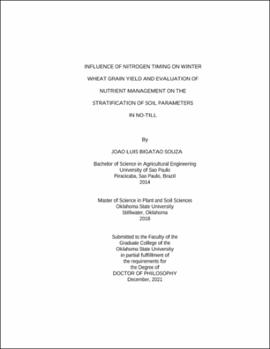| dc.contributor.advisor | Arnall, Daryl | |
| dc.contributor.author | Bigatao Souza, Joao Luis | |
| dc.date.accessioned | 2023-03-16T16:40:47Z | |
| dc.date.available | 2023-03-16T16:40:47Z | |
| dc.date.issued | 2021-12 | |
| dc.identifier.uri | https://hdl.handle.net/11244/337094 | |
| dc.description.abstract | Visual symptoms of nitrogen (N) deficiency is common in winter wheat fields. Whether it is due to unavailability of suitable application equipment or unfavorable application conditions, the crop may go a significant period without fertilization. The objective of this study was to evaluate the impact of N applications made after winter wheat is under N stress for an extended period. The study was conducted across 12 site-years in Oklahoma. Treatments included control, pre-plant application and ten in-season treatments. In-season treatments were initiated at the point N deficiency was visually identified. Treatments were applied in progressive order every seven growing days to the point of 63 growing days after visual differentiation (DAVD). A negative effect on grain yield was observed when application was made post Feeks 8. The data suggested forgoing N application until Feekes 7, regardless of deficiency, had no negative impact on yield and in some cases increased yield above the pre-plant application. This documents that winter wheat producers have a much wider N application window than traditionally believed. No-till (NT) management directly influences chemical, biological and physical proprieties in the soil, affecting nutrient dynamics. In the second chapter, our objective was to quantify soil chemical attributes stratification in continuous wheat in three long-term dry-land sites under NT at least for nine years. Available Phosphorus (P) and potassium (K), total nitrogen (TN), organic carbon (OC), pH and exchangeable aluminum (AlKCl) were quantified. We found that stratification occurred for all soil attributes tested in the study, with P, K, TN, OC and AlKCl being greater near the soil surface and pH being lower. Soil pH, TN, and OC stratification were generally related to the rate of annual N fertilization. Although not at the same magnitude, non-fertilized plots were likewise stratified for the tested parameters, which indicates an isolated effect of the NT on the stratification rather than the fertilizer addition. Organic carbon and TN were highly stratified in the first 5cm and little or no impact was noticed in deeper soil layers. Attention regarding sampling depth in NT areas is essential for an accurate soil attributes monitoring and fertilizer recommendation. | |
| dc.format | application/pdf | |
| dc.language | en_US | |
| dc.rights | Copyright is held by the author who has granted the Oklahoma State University Library the non-exclusive right to share this material in its institutional repository. Contact Digital Library Services at lib-dls@okstate.edu or 405-744-9161 for the permission policy on the use, reproduction or distribution of this material. | |
| dc.title | Influence of nitrogen timing on winter wheat grain yield and evaluation of nutrient management on the stratification of soil parameters in no-till | |
| dc.contributor.committeeMember | Zhang, Hailing | |
| dc.contributor.committeeMember | Warren, Jason | |
| dc.contributor.committeeMember | Maness, Niels | |
| osu.filename | BigataoSouza_okstate_0664D_17501.pdf | |
| osu.accesstype | Open Access | |
| dc.type.genre | Dissertation | |
| dc.type.material | Text | |
| dc.subject.keywords | long-term | |
| dc.subject.keywords | nitrogen timing | |
| dc.subject.keywords | no-till | |
| dc.subject.keywords | nutrient management | |
| dc.subject.keywords | soil attributes stratification | |
| dc.subject.keywords | winter wheat | |
| thesis.degree.discipline | Soil Science | |
| thesis.degree.grantor | Oklahoma State University | |
